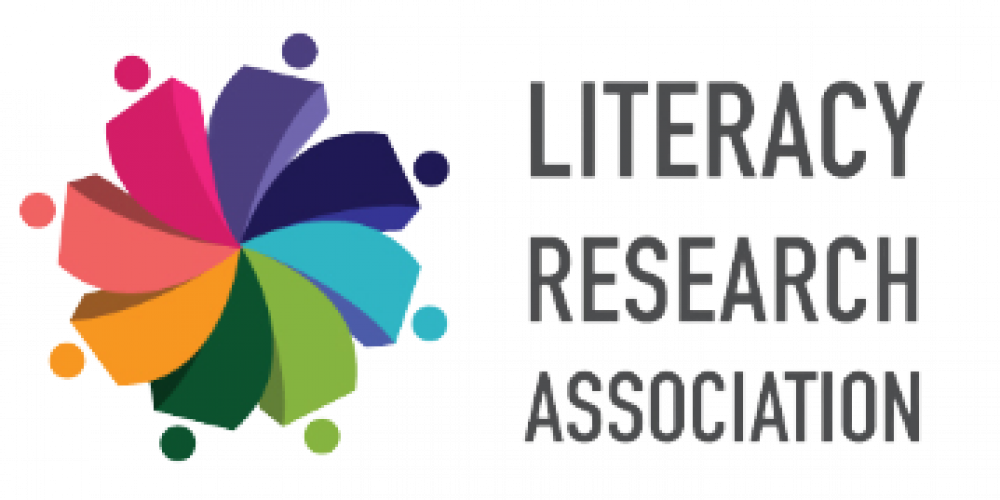Catherine Compton-Lilly, University of South Carolina
Marcus Croom, Indiana University
Mary McVee, University at Buffalo, SUNY
Allison Skerrett, The University of Texas at Austin
As the 2022 LRA Conference came to a close, members gathered to attend the annual integrative review of literacy research. Panelists pursued a shared goal; as literacy scholars, we intentionally and systematically sought to dismantle the biases often imposed on Black, Indigenous, and People of Color through four review-oriented projects that – each in its own way – attempted to counter the systemic whitewashing that has characterized review scholarship in literacy. Significantly, scholarly reviews have long-term effects on scholarly communities, they provide novice and established scholars with macro views of the field, while identifying what is important and worthy of our attention.
Across the papers presented by this panel, we explored silences and obfuscations relative to the voices of Scholars of Color, the experiences of Communities of Color, and the education of all children. This public presentation of syntheses was organized as an intentionally anti-racist act designed to name, describe, and recognize the voices and contributions of People of Color. Below, we briefly describe the presentations of the fours scholars: Catherine Compton-Lilly, Marcus Croom, Mary McVee, and Allison Skerrett.
A Metasynthesis of Family Literacy Scholarship by Black, Indigenous, and People of Color
To explicitly and intentionally explore the scholarly contributions of Black, Indigenous, People of Color (BIPOC), Catherine Compton-Lilly shared an metasynthesis being conducted in collaboration with Tisha Lewis Ellison and Rebecca Rogers. Qualitative metasynthesis provides a review methodology for integrating findings from across primary qualitative research studies that focus on a particular issue or body of scholarship. For our metasynthesis, we explored findings from studies that had particular relevance to our work as scholars with a shared interest in literacy practices in families and communities.
Following an extensive search of academic databases, we sought journal articles authored by BIPOC Scholars whose voices and perspectives have informed our own work as literacy scholars with an interest in families. Selected articles described an empirical study and included a detailed methodological information. Each articles reported on a qualitative research study that was relevant to literacy learning and/or practices in families and communities. Below, we briefly present a few findings from that synthesis. I focus on findings that highlight family literacy as involving time and temporality; well-being, emotionality, and joyful practice; and activism.
Findings related to time and/or temporality point to the longitudinal legacy of resources and knowledges that BIPOC families and communities bring to literacy learning, including: cultural and familial stories; powerful and emotive memories of strength and resistance; linguistic and transnational expertise; sustained cultural identities; and ancestral inspiration gleaned from past generations. For example, Prichard (2014) addressed historical erasure and advocated for the re-writing selves and communities, explaining that through the reading and writing of descendants “ancestors gain the advantage of being resurrected from the slow death of historical erasure” (p. 34). 1
Other relevant findings involved well-being, emotionality, and joyful practices. These findings that highlighted literacy practices as creating spaces of connection, communication and support. Lewis (2013) explored emotionality through her analysis of an African American mother and son’s collaborative digital literacy practices 2, while Flores’ (2018) focused on the narratives that Latinx mothers and fathers shared during writing workshops with their daughters. 3
Finally, BIPOC scholars identified family literacy practices as forms of activism. Campano and his colleagues (2013) explored the activist nature of coalitional literacy practices in community contexts 4, while Souto-Manning (2018) focused on family involvement in early childhood education. 5
Based on our analysis of these findings, we believe that BIPOC voices are significant and offer important lenses for all of us as literacy scholars. By highlighting these counter-stories and their temporal, spiritual, and agential roots, BIPOC scholars recognize and honor the humanity and resourcefulness of participants and communities, providing powerful lessons for researchers and teachers who aspire to work with and in BIPOC Communities.
Characterizing and Traversing Racial Literacies Scholarship
Crossing among inquiries and insights, this review characterized racial literacies scholarship and highlighted examples to traverse and advance this essential literature toward post-White futures for us all. As Croom explained, “racial literacies” is a clarifying term encompassing complex, historical, ongoing race critical understandings and practices that have developed among individuals, groups, and institutions amid multifaceted human racialization. Notably, racial literacies are not new literacies; thus, “racial literacies” is a new term that expands upon and further theorizes “racial literacy,” including various uses of this construct posed since France Winddance Twine (sociology) and Lani Guinier (law) published on this construct, for example.
In his panel presentation, Croom brilliantly placed this scholarly review in context 6 noting that:
-
- Neither identities nor forms of labor exempt us from the work of developing racial literacies,
- Black-White binaries must be resisted,
- White folks must be addressed but without a preoccupation with White folks,
- Youth are past, present, and future participants in ongoing race practices,
- Anyone can be anti-Black, anti-Indigenous, anti-Brown, and so on,
- Anyone can be post-White (which is never anti-White) and anyone can practice “a transcendent approach to literacy”, and 7 8 9 10
- Racial literacies are for all.
Therefore, “racial literacy” has begun to be understood according to practice of race theory (PRT) which organizes the varying uses of this construct within the umbrella of “racial literacies” and illuminates some antecedent race critical understandings and practices beyond and within the field of literacy research.
After defining basic terms and criteria for racial literacies scholarship based on history, theory, and examination of existing literature reviews of “racial literacy,” Croom’s review identified the need for basic definitions and criteria for identifying racial literacies scholarship prior to conducting a comprehensive review. For example, racial literacies scholarship refers to inquiries and insights about situated race practice. Additionally, Croom identified racial literacies as:
-
- thinking and doing race for human well-being,
- different from new literacies,
- different from critical thinking and critical literacy,
- included among multiple literacies,
- developing through multiple routes, and
- contributing philosophically, theoretically, pedagogically, and politically to what we understand about living and learning.
After sharing the basic definitions and criteria identified through this synthesis, Croom maintained that further reviews of racial literacies scholarship are needed. Such future reviews should use clear exclusion and inclusion criteria and explicit definitions of terms (e.g. race, literacy, racial literacies) to prevent unsystematic analyses and conclusions. Having shown the theoretical, historical, current, and anticipated race trajectories that can be clarified by the racial literacies construct, Croom finds that this construct is useful to researchers, practitioners, policymakers, and the public. 11 12 13
Racialized Emotions in the Narratives of Literacy Teachers, Teacher Educators, and Researchers
Dr. Mary McVee and her colleagues (Dr. Aijuan Cun and Dr. Kristian Douglas) focused on racialized emotions that are group-based and grounded in relationships. These racialized emotions are predicated upon the histories of racialized systems and individual lives. McVee and colleagues posed narrative as an important means of representing and constructing racialized emotions. As they noted, narrative can be enacted externally, as a spoken story, a video, or an image; thus, narrative is a tool that communicates meaning and positions. Internally, narrative is used by individuals and communities to organize and make meaning within the interior landscapes of the self. All narratives are dynamic and fluid. They may be captured on the page and in print as static and durable, but to their narrators–real people in the real world–narratives can always be changed, re-interpreted, and re-positioned. While the concept of racialized emotions is not new, studies of emotion in education and literacy education have received scant attention. Despite these silences, scholars, Scholars of Color have explored racialized emotions through narrative inquiry, autoethnography, and counter-narrative, revealing narrative as fertile ground for exploring learning, identity, position, and racialized emotions.
McVee and colleagues presented illustrative examples that draw on the work of respected literacy scholars. They described the work of Ohito who employed narrative inquiry to critically consider affective and embodied literacies, while highlighting healing and reparative practices and spaces. 14 Similarly, they discussed Jackson’s autoethnography of her work as a Black teacher-researcher in collaboration with a Black teacher as they sought to center justice-oriented solidarity and Blackness. 15
Other examples included Baker-Bell’s autoethnographic challenges to the “strongblackwoman trope” (p. 526) as she discussed personal narratives related to her experiences as a Black woman scholar on the tenure track. 16 Finally, McVee and colleagues presented the childhood narratives of Washington, Bauer, Edwards and McMillon as they documented their journeys from girlhood to the academy” and challenged monolithic narratives of Black girlhood and becoming university educators. 17
While all of these narratives do not explicitly name emotions, each narrative telling or retelling provides readers with a sense of how racialized emotions are represented and lived. These remarkable stories reveal significant risk-taking on the part of tellers who challenge not only literacy teachers, but turn their gaze inward to the fields of research, teacher education, and individually to themselves. While grounding their writing in emotion-laden landscapes and foregrounding self-reflective practices, these scholars raise substantive and critical issues, while presenting calls and practical suggestions for enacting justice, equity, solidarity, and anti-racist positions. In letting loose the currents of racialized emotions within and across these works, scholars disrupt willful blindness of racialized emotions and status quo beliefs about what “should” be thought, acted upon, or even felt. In so doing, they highlight powerful connections between emotions and power. 18
Banned Books and Banners for Change: Literacy Education for Troubled Times
During times of deep change and duress, youth have been alternatively, and sometimes paradoxically, positioned as significant contributors to, or manifestations of, troubled times. However, they are simultaneously positioned as the people best poised to tackle social challenges and positively transform their societies. 19 In her review of literacy in troubled times, Allison Skerrett reported on emerging research with young people related to the Covid-19 pandemic, their involvement in social movements and demands for racial justice, and growing efforts to censor students’ and teachers’ engagements with particular texts.
Skerrett explored how youth have experienced the Covid-19 pandemic including shifts to virtual schooling, their mental and physical health, and their social relationships and practices. 20 21 While young people have reported physical and mental challenges from long hours tethered to computer screens and being apart from their peers, this small body of emerging research has also suggested that youth exercised agency and innovation in caring for themselves and one another. These counter-narratives attest to the agency and contribution of youth in navigating troubled times. Thus, care must be exercised to not inadvertently re-inscribe deficit perspectives of young people and mask their agency in generating productive responses to personal and societal challenges. 22
Skerrett also reviewed studies that examined the effects of the heightened visibility of anti-Black violence, including the murders of unarmed Black citizens George Floyd, Breonna Taylor, and others by police officers that resulted in social protests and demands for racial justice. Anti-Asian violence, stoked by dangerous rhetoric from US leaders that absurdly attempted to racialize a virus, also saw a sharp increase. Young people have been at the forefront of agitating for racial justice. The Black Lives Matter movement, founded and energized by Black youth and their co-conspirators, has been arguably the most visible activist group in recent times. 23 24
In education and across the country, there has been a growing movement to censor students’ and teachers’ engagements with particular texts. Linked to anti-critical race theory conservative movements, some social groups have attempted to ban texts that focus on race, racism, and LGBTQ+ issues 25 26 Apparently, some parent and citizen groups do not want their children to develop their awareness of racism and heterosexism while being equipped with tools and dispositions to create a more just world. 27 Young people (see Washington Post, 2022; Woodcock, 2002) have led the way in challenging these efforts. 28 While young people have always been positioned as a mirror of and a contributor to the current times, these last few years present an ideal time to explore how they negotiate these social positions. 29 As Skerrett maintains, there is no better time for literacy research/ers to listen to and learn from youth.
Please cite this work: Compton-Lilly, Croom, McVee, & Skerrett (2023). Dismantling the Biases Imposed on Black, Indigenous, and People of Color. Literacy Research Association Critical Conversations. CC BY 4.0 license.
Cover Photo by Chris Anderson on Unsplash



